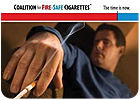Still, the disparity between the two numbers made me wonder about the efforts of the National Fire Protection Association to make fire-safe cigarettes mandatory in all 50 states. NFPA coordinates the Coalition for Fire-Safe Cigarettes and devoted part of its booth at its trade show last month in Las Vegas to educating attendees such as myself.
The coalition has delivered remarkable success since it began its nationwide drive, state by state, two years ago. Eleven states have enacted legislation to mandate fire-safe cigarettes and 24 more have passed laws that are awaiting governors’ signatures.
Perhaps as important as its successes, the coalition may have established a template for grass-roots movements that could transform the fire-protection industry through other initiatives, including residential sprinklers. NFPA President and CEO James Shannon made the connection during his remarks at the recent convention’s opening session.
Manufacturers can make their cigarettes fire-safe by wrapping the tobacco with two or three thin bands of less-porous paper that act as “speed bumps.” If a fire-safe cigarette is left unattended, the burning tobacco will reach one of these speed bumps and self-extinguish.
The technology to produce fire-safe cigarettes apparently has been around for decades. The tobacco industry, for whatever reason, chose not to manufacture fire-safe cigarettes on a widespread basis until the coalition pressured it to do so. Imagine that.

Photo
courtesy of www.usfa.dhs.gov
That such a grassroots effort could take on as powerful a lobby as the tobacco industry gives some residential fire sprinkler advocates hope. They believe they could find success with a similar initiative confronting a home-building industry that has lobbied diligently to prevent legislation mandating fire sprinklers in single-family home construction.
While I spoke at the NFPA show with one deputy fire marshal who questioned whether the formation of a new coalition for home fire sprinklers only would prolong a battle in which he personally has been involved for years, we believe that this approach has merit. The state of the home-building industry today may make it more receptive to a rejuvenated effort by sprinkler advocates, public safety officials and others that would make new homes safer and more attractive to buyers.
We applaud the efforts of the Coalition for Fire-Safe Cigarettes to save lives and protect property by compelling tobacco companies to make a simple change to its product. With the stakes being much higher, a similar initiative should be made to convince home builders to follow suit with fire sprinklers.
